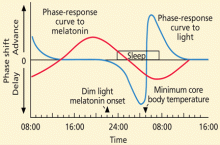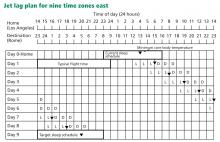Jet lag and shift work sleep disorders: How to help reset the internal clock
ABSTRACTJet lag sleep disorder and shift work sleep disorder are the result of dyssynchrony between the internal clock and the external light-dark cycle, brought on by rapid travel across time zones or by working a nonstandard schedule. Symptoms can be minimized by optimizing the sleep environment, by strategic avoidance of and exposure to light, and also with drug and behavioral therapies.
KEY POINTS
- Symptoms include daytime anergia, alternating complaints of insomnia and hypersomnia, emotional disturbances, and gastrointestinal distress. The severity depends on the degree and the duration of dyssynchrony, as well as on innate factors such as age and whether the patient is an “early bird” or a “night owl.”
- Drug treatment addresses sleep-related symptoms (eg, somnolence, insomnia) and attempts to hasten circadian reacclimation.
- Exposure to bright light in the hours leading up to the patient’s minimum core body temperature tends to push the internal clock later in time, whereas bright light in the hours immediately afterward pushes the clock earlier in time.
JET LAG SLEEP DISORDER
Jet lag results from air travel across multiple time zones, with a resultant discordance between the internal circadian clock and the destination’s light-dark cycle. Most sufferers report sleeping poorly at night and feeling groggy during the day, and some also experience general malaise and gastrointestinal distress.1
The severity depends on a number of variables.
Going west is easier than going east
Westward travel is normally less taxing than eastward travel, as it requires setting one’s internal clock later rather than earlier. Presumably, because the circadian period tends to exceed 24 hours, we can move our internal clock later by about 2 hours per day, but we can move it earlier by only 1 to 1.5 hours.15,16
The more time zones crossed, the longer it takes the circadian pacemaker to re-entrain and the longer-lasting and more severe are the symptoms of jet lag. Travel across one or two time zones is only transiently troublesome.
Does age affect jet lag?
Whether age affects the severity of jet lag is not yet known.
In a study of simulated jet lag (requiring a 6-hour advance), middle-aged people (ages 37 to 52) experienced a greater degree of fragmented sleep on polysomnography than younger ones (ages 18 to 25). The older group also had greater impairment in daytime alertness, suggesting that phase tolerance—ie, the ability to sleep at an abnormal time in the circadian cycle17—decreases with age. However, two field studies involving both eastward and westward travel yielded the opposite results, suggesting that older age may actually protect against jet lag.18–20
Methodologic differences preclude direct comparisons of the studies, as do differences in the age groups studied.
Light exposure can help or hurt, depending on the timing
Our core body temperature dips to its lowest point about 2 to 3 hours before we habitually awake. Exposure to bright light in the hours leading up to this minimum (the inverted triangle in Figure 2) sets our internal clock later (a phase delay)—desirable, say, for someone travelling from New York City to Los Angeles. Conversely, exposure to bright light after this temperature minimum sets the clock earlier.
Inadvertent shifting of circadian phase in the wrong direction (“antidromic re-entrainment”) is common and delays circadian reacclimation and the dissipation of jet lag symptoms.
We discuss ways to reduce antidromic reentrainment in more detail further below.
Other factors
Other factors that contribute to travel fatigue include sleep deprivation (before the flight or en route), acute discomfort as the plane ascends to its cruising altitude,25 and excessive alcohol or caffeine intake during the flight. Although the effects of these factors rapidly diminish once one reaches the travel destination, jet lag will persist until circadian re-entrainment occurs.15
NONDRUG THERAPIES FOR JET LAG SLEEP DISORDER
The goal of treatment is to realign the circadian rhythm in the most rapid and efficient way and to minimize symptoms in the meantime. Frequent shifts to different time zones, often required in business travel, are very difficult to accommodate, and business travelers actually may do better if they remain on their home-based schedule.
One study compared keeping home-based sleep hours as opposed to adopting local sleep hours during a 2-day stay after a 9-hour westward flight.26 Travelers who remained on home-based hours were less sleepy and had lower (ie, better) global jet lag ratings than those who adopted local sleep hours, in part because of better sleep quality and duration. Nevertheless, about one-third of the participants said they preferred to adhere to the local schedule.
Strategic avoidance of, and exposure to, light
If the traveler intends to remain at the destination long enough, he or she can adjust better (and avoid an antidromic process) via strategic avoidance of and exposure to light.24
People travelling east, who want to set their clocks ahead (a phase advance), need to keep to the dark in the 3 hours leading up to the time they reach their minimum core body temperature (depicted as “D” in Figure 3), and then expose themselves to light in the 3 hours immediately after (“L” in Figure 3). Thus, the traveler from Chicago to Paris would do better by avoiding light exposure on arrival, either by remaining in darkness in his or her hotel room, or by wearing dark sunglasses when outdoors. Wearing sunglasses during transit to the hotel would also help avoid light exposure.
When attempting to delay circadian rhythms, the opposite light-dark patterns are sought, as depicted in Figure 4. As flight and layover patterns often do not permit strict adherence to these measures, they represent idealized scenarios.
The first step is to make a grid with a concurrent listing of home and destination times. In the example in Figure 3, the person is traveling seven time zones east. On day 0, a rectangle is drawn around the times representing home-based sleep hours.
Next, we mark the time at which we expect the traveler’s core body temperature to reach its minimum (inverted triangle). If the person habitually sleeps no more than 7 hours per night, then we mark this point as 2 hours before his or her habitual wake-up time; if the person sleeps more than 7 hours, then we place it 3 hours before wake-up time.23,29 This process is repeated at the bottom of the grid to represent the desired sleep schedule at the traveler’s destination. The distance between the home and the destination-based minimum core body temperature symbols represents the required degree of circadian realignment.
If a phase advance is required (eg, if travelling from Chicago to Paris), the core body temperature symbol is drawn on day 1 in the same location as day 0. For each subsequent day, the symbol is moved 1 hour earlier (which is about how fast the internal clock can advance),15,27 until a clock time within 1 hour of the desired destination core body temperature time is reached or satisfactory sleep and daytime functioning are achieved (Figure 3). If a phase delay is required (eg, if travelling from New York City to Los Angeles), the symbol is drawn 2 hours later on day 1 than on day 0 (reflecting the greater ease at which delays are achieved),15,27 with subsequent daily shifts in 2-hour increments, again until a clock time within 1 hour of the desired destination minimum core body temperature time is reached or satisfactory sleep and daytime functioning are achieved.
Requirements for darkness can be met with protective eyewear (ie, dark sunglasses), or by remaining in a dark room. Light requirements can be met with outdoor exposure, with a commercial light box, or with a separate apparatus (eg, goggles, visors) portable enough for travel.









